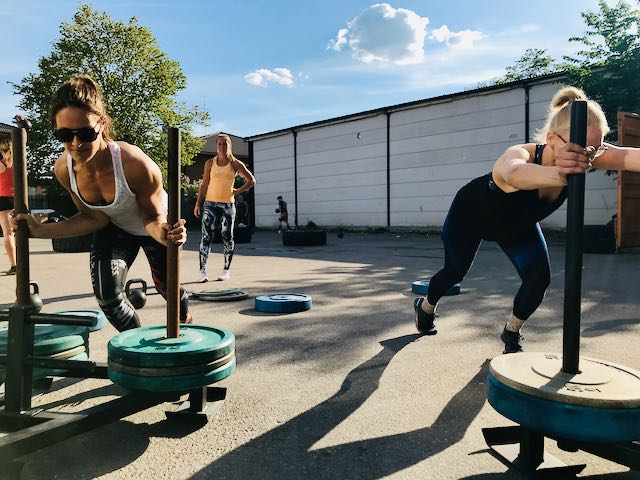A conservative is a man with two perfectly good legs who, however, has never learned how to walk forward.
Franklin D Roosevelt
Stronger legs is associated with enhanced general sports skills as rate of force development and external mechanical power expressed in movements like jumping, sprinting and change of direction as well as specific sport performance. It is also enhanced with decreased injury rates. Since athletes started accompany their on field training with exercises in the weight room, the undisputed king of the movements to get stronger legs has certainly been the squat.
The Hegelian Dialectic holds that conventionality, staying within the box of conventional thought, gives rise to a thesis. Every thesis eventually gives rise to an antithesis, a challenger: a rebel arises, assaulting the conventional barricades of the thesis. A fight ensues and out of the ashes rises a third idea, a synthesis, resolving the conflict, and becoming the new normal, the new thesis.
It’s hard to find more obvious examples of this than when Mike Boyle stood up in 2009 and said “don’t do squats anymore” declaring the first and foremost tool used to create strong athletes is obsolete.
I am no cultural anthropologist, but it seems to me that this very moment was important in order to create the rift between the functional movement-crowd, who laugh at those training like powerlifters, and the old-school weight lifters rolling their eyes when seeing the guys doing the split squats.
Obviously the initial idea was met with a backlash, and both sides have since then sharpened their arguments. And the main arguments for single leg exercises goes something like this
- Most sports are played on one leg at a time, hence they are more specific and should transfer better to sports performance
- The requirements of proprioception (the sense that people have of knowing where the parts of their body are) and core stability is greater when doing single leg rather than double leg variations
- Single leg exercise balances out imbalances in strength between sides of the body, as you can no longer shift more onto your potentially stronger side making up for the lack of strength of your potentially weaker side.
- Less stress placed upon the lumbar spine, decreasing the risk for back injury
Whereas the bilateral (double leg exercise, like the squat) proponents line of arguments would be similar to the list below
- You cannot load the single leg lifts like you can the double legged variations.
- Specificity and mimicking is not the same thing: the goal is to strengthen a function, regardless of how it looks.
- The loading on the spinal column might be less in absolute terms for single leg exercises, but it is also both asymmetrical and done with less balance.
Basically the first arguments form both sides is regarding specificity and transfer of complementary training into sport performance. The main point for the unilateral-side is that regardless of the lesser overload being put on the athlete performing the single leg exercise, the movement being more similar in the joint-synchronization, the coordination of movement between body parts, to what he or she does on the field should yeld more carry-over of what capacity is increased.
Car analogies are popular to use with this line of reasoning, such as that if we “increase the engine while still driving on bad brakes and tires” we would still not be able to express the strength of that engine. This strategy seeks to increase the robustness of the movement pattern by keeping them contextual, so that the system as a whole will shift towards a greater force production.
And single leg training would potentially allow for more overload of the legs, as less core strength is likely to be required when moving lesser loads. Removing this as a limiting factor might just build stronger legs.
The comeback would be that this still limits the possible overload that you can place on the system as a whole. And because of this you would limit both the mechanical loading on the whole muscle and tendon, as well as not stimulating the central nervous system and synapses, thus missing out on neural aspects of improved force production.
Both arguments are sound to me.
Next, there is the argument of structural balance, leveling the differences in mobility and strength between sides of the body, from training one side at a time. Which is an argument that both “sides” share to some extent, for neither is advocating to train muscles fully in isolation. And with compound movement a synchronized chain of action is strengthened while being carried out.
Something that could be said against the idea to make all athletes symmetrical is that the fastest man we’ve seen so far, Usain Bolt, showed that you could be running with an asymmetrical stride (from scoliosis and a right leg a half-inch shorter than the left) and still be the apex predator of the track and field.
So while addressing all asymmetry seems overly categorical, when faced with pain or dysfunction we need to react and remedy somehow. And when the hands or legs are not connected by a barbell, or one side is trained at a time, more degrees of freedom are appears. This could good for the people with dysfunction in the hip or shoulders, because that means that they can let their body “solve the problem”, finding ways to move without pain.
So, again, both arguments would be sound depending on the context.
Finally, the loading of the spine is usually mentioned. Lesser loads on the spine and the injury risk should decrease with it. Yes, but one would not want to spare the spine from loading altogether, because this would not build the muscles needed to stabilize the spine in sports and life. So the truth would seem to be somewhere in between to much and too little. If you tolerate high loads, then that might be better. And certainly, as we shall see, lesser loads calls for higher volume of training, which translates into something that is also a possible cause for injury: fatigue.
The argument of bilateral force deficit, that the total amount force produced during two unilateral contractions is greater that the force produced a single bilateral contraction, seems quite irrelevant as it seems that both types of training can improve strength to a similar degree, but with specificity of movement yielding the most benefits (an argument already made).

When it comes to training strength there is multiple ways to skin the cat, but all of them includes sets of exercises that are completed close to, or to the point of failure to work the largest motor units and to induce sufficient mechanical and neuromuscular stimuli. This means we could be using either moderate loads and higher number of repetitions or heavier loads coupled with a lower number of repetitions.
But by keeping volumes lower and intensity higher, we would be where we need to be from a strength point of view, and never tired from too much complementary training. Which could render us unable to do well on the field where true specificity, and true speed, is to be found. Excessive fatigue alter movement mechanics both in and outside of the gym, having implications for training practice and injury risks. If we are making our athletes unable to train at the speed demanded from them come game time we are at best not setting them up to win, and at worst they are not able to react quickly enough to unexpected events rendering them susceptible to injury.
As a general rule: chasing maximal neural drive and velocity in each lift enables us to get more out of less. With more stability and balance, as you get standing both legs, you get just that which should seem to favor double legged exercises.
But irrespective of exercise used movement mechanics are changed when approaching that point of failure. Specifically a reduction in moment at the knee made up for with an increase at the hip and the lower back. And when this coordination in movement between body parts is changed we are no longer being contextual and we are now overloading muscles, rather than the desired movement.
The triple extension, the synchronized opening of the ankle, knee and hip, that is so important in sports because it allows to produce maximum power against the ground, is compromised when the knees extend ahead of the hips. This could even lead to altered extension mechanics, if we do it often enough, something deeply undesirable for most athletics.
So, heavy weights coupled with intent might offer improved force production from central stimulation – but when doing so also changes joint synchronization and muscle coordination. This seems to me very problematic for heavy strength training. At best meaning the capacity will not carry over as well as it could to the field, and at worst actually decreasing sports performance.
We are faced with a dilemma where there is no correct choice to be seen.
- Overly fatiguing athletes is just not ok, they must be able to perform their best in their sport specific sessions.
- Double leg strength movements might be less intentional, but suited for heavier loads coupled with a lower number of repetitions – minimizing fatigue – but might because of that disrupt joint-synchronization.
- Single leg strength movements, while more intentional, are nicely suited for moderate loads and higher number of repetitions. But when doing that, the repetitions up until those last ones are neither working the largest motor units nor giving much neuromuscular stimuli. But causing quite a bit of fatigue. And when we get to the “money reps” we still have the drawbacks of the altered movement mechanics.

- “Unilateral vs. Bilateral Training: What’s Best for Athletes?”, https://www.stack.com/a/unilateral-vs-bilateral-training-whats-best-for-athletes
- ”The Dirty Secrets of the Single Leg Training Craze”, https://simplifaster.com/articles/single-leg-training/
- “A Reaction to “Dirty Little Secrets of the Single Leg Training Craze”, https://strengthcoachblog.com/2018/03/07/a-reaction-to-dirty-little-secrets-of-the-single-leg-training-craze/
- “Something Strange in Usain Bolt’s Stride”, https://www.nytimes.com/2017/07/20/sports/olympics/usain-bolt-stride-speed.html
- “The Effective Applications For Unilateral Vs Bilateral Training”, https://breakingmuscle.com/fitness/the-effective-applications-for-unilateral-vs-bilateral-training
- “What is training volume?”, https://medium.com/@SandCResearch/what-is-training-volume-286b8da6f427
- “Impact of performing heavy-loaded barbell back squats to volitional failure on lower limb and lumbo-pelvis mechanics in skilled lifters”, https://www.ncbi.nlm.nih.gov/pubmed/31638481
